The Hebrew University debate on Global Warming
Blog topic:

The panel. From left to right: Prof. Colin Price, Prof. Nathan Paldor, Prof. Dan Yakir, and myself.
Synopsis
Although it was called a debate, it wasn't really one. It included 4 short presentations (about 12 mins each + 3 min for clarifying questions) and then another 45 mins of questions from the audience.
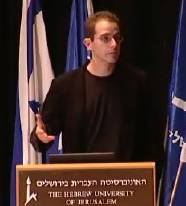
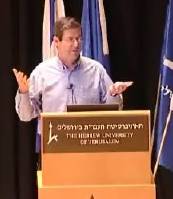
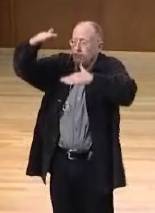

Before addressing the critiques, let me add that neither Yakir nor Price brought any evidence proving the standard anthropogenic scenario. Yakir did not attempt to prove anything (there is no need since the majority of scientists anyway support it), and Price did bring supporting evidence, but evidence that in reality does not prove anything about the validity of the AGHG theory.
The main claim raised by Price was that when computer models are used to fit 20th century warming, they do a very lousy job if you include all the natural forcing only, but they do a wonderful job if you include the anthropogenic forcing as well. This supposedly implies that one needs the large anthropogenic contribution to explain the warming. The key point here is that the natural forcings included all the known forcings, and not the unknown forcings, or specifically, the large indirect solar/climate link which these models fail to include, because the modelers bluntly neglect this mechanism. More about it here.
Although Yakir and Price did have a chance to address the critiques I raised about the AGHG (unlike the opposite), they chose not to.
The claims against the cosmic ray climate link, and why they are wrong or irrelevant
Following are the specific claims raised by Profs. Yakir and Price against the cosmic ray climate link and explanations for why the claims are either irrelevant or wrong.
• The Danish group arbitrarily manipulated the cloud data to fit the cosmic ray flux variations: Although many would not like to admit it, there is a clear satellite cross-calibration problem with the ISCCP data, around 1994. This is clearly evident if one looks at the high altitude clouds which exhibit a very unnatural jump around the end of 1994. Although no dramatic climate events took place, there is a jump which is larger than the variations before or after the "event", as can be seen in the figure (from Marsh & Svensmark 2003).
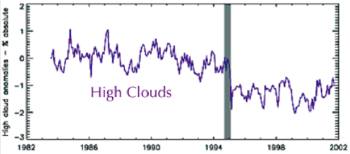
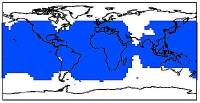
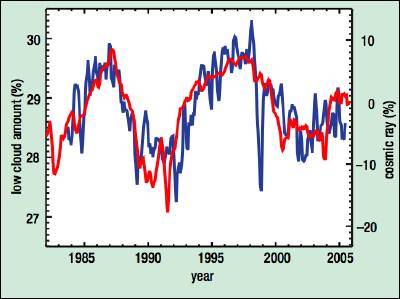
Higher up the atmosphere, there are plenty of ions, but less aerosol building blocks, implying that the ions are not a bottleneck anymore. Thus, changing their abundance at high altitudes will not have a significant effect on the formation of condensation nuclei. This was shown also in a numerical simulation by Yu (2003).
• Prof. Yakir mentioned that if the solar/climate link is correct, there should be climate variations observed in sync with the 11-year solar cycle. In fact, the literature includes many analyses showing that the land and ocean surface temperatures vary by about 0.1°C between solar minimum and solar maximum (e.g., White et al. 1997, Douglass & Clader 2005, Shaviv 2005, and Camp & Tung 2007). This does not sound a lot, but it is about 10 time larger than one would expect from variations in just the solar luminosity.
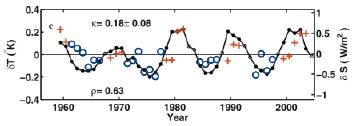
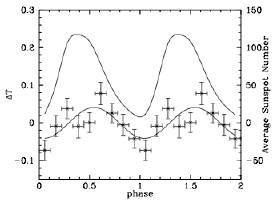
• Prof. Yakir said that the CRF/climate theory is not consistent with the observed decrease in the diurnal temperature variations (namely, that the nights warmed more than the days). He expects this result because the warming associated with the CRF/climate link is through a decrease in the amount of clouds. A larger direct insolation during day time would increase the diurnal cycle, and not decrease it. However, Yakir is probably unaware that the CRF/climate link is expected to operate only where there is very little background cloud condensation nuclei, namely, in the marine layer over oceans. This means that direct variation of the cloud cover over land is not part of the link, it will only arise from the feedbacks in the system. Since we expect a warmer climate to have more water vapor in the atmosphere, we will also expect to form more clouds over land, and reduce the IR cooling during the nights, two effects that reduce the diurnal cycle.
• Prof. Price has shown a lack of correlation between cosmic ray and climate over a 20-30 year period (citing the work and showing the graphs of Lockwood and Frölich 2007). In short, L&F assume that there should be a one to one correspondence between cosmic rays and temperature, but they neglect the fact that the climate system is a low pass filter. It introduces delays which increase with the time scale of variations, at least up to about a century. For example, over a day, the maximum radiation is reached around noon while the highest temperature at around 2 pm. On the annual time scale, the maximum radiation to the northern hemisphere reaches around late June, but the warmest period is typically more than a month later.
Similarly, even though there was a reduction in the solar activity (and increase in the average cosmic ray flux) over the last solar cycle, the oceans still emit heat from the large amounts its absorbed over the latter half of the 20th century. Just comparing the average over 2 solar cycles (the 11-year signal was averaged out in the L&F graphs), is like comparing the temperature between noon and 2 pm with the solar insolation, and reaching the conclusion that solar radiation decreases the temperature. More about it here.
Incidentally, I find it to be either hypocritical or out of ignorance that people to call me "disingenuous" for mentioning the same heat capacity used in other aspects of global warming. When it suits their needs, it's kosher, when it doesn't, it's disingenuous. Go figure.
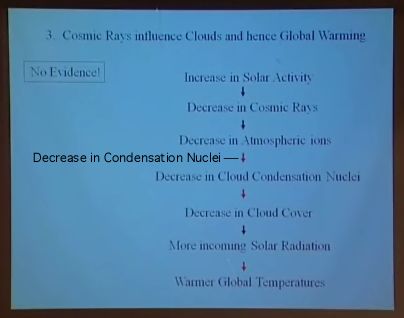
The problematic links within the cosmic-ray climate picture, according to Prof. Price. The black arrows are undisputed links, the red ones are links Price disagrees on, or at least doubts. The added link is one that Prof. Price should have added, this is because forming small condensation nuclei and forming the large cloud condensation nuclei upon which the water vapor condensation takes place, is not the same thing.
Here are my comments about the "red arrowed" links:
1. Formation of condensation nuclei from atmospheric ions: This was shown in several results (Eichkorn et al., Harrison & Aplin 2001, Svensmark et al. 2007). The last is a full fledged cloud chamber mimicking oceanic conditions. It was found that increased ion density increase the formation rate of condensation nuclei. Flat and simple.
2. The formation of cloud condensation nuclei from condensation nuclei, namely, the formation of particles which are perhaps 100 larger (in size), required for the actual water vapor condensation. This step was not shown yet in the lab (e.g., the last experiment described above is not large enough - the particles stick to the walls before they have the time to grow to large particles), but it was shown in a numerical simulation that if the density of background particles is small, then the small condensation nuclei will coalesce to form the large cloud condensation nuclei.
3. Decrease in the cloud cover from a decrease in the cloud condensation nuclei density: The evidence for this effect is ship tracks (besides having ample theoretical support). Namely, in regions where there are more condensation nuclei (e.g., ship exhaust particles) the clouds are whiter.
4. Decrease cloud cover causes a warmer climate: Since the dominant effect is on low clouds (observed empirically, and expected theoretically), and since it is well known from the Earth Radiation Budget Experiment that low clouds have a strong cooling effect (that is, the cooling albedo [reflectivity] effect is much more important that the IR blocking [blanket] effect]), the reduction in low clouds from the decrease in atmospheric ionization will cause warming.
In addition, one should realize that there are many empirical findings showing that it is cosmic rays which are affecting the clouds and climate, and not something else which is more directly related to solar activity. These include my work on cosmic ray flux variations over geological time scales (Shaviv 2003, Shaviv & Veizer 2003), the same latitudinal dependence of the cloud variation as the high energy cosmic rays reaching the lower troposphere (Usoskin et al., 2004), correlations between cloud cover and short term cosmic ray variations (Harrison & Stephenson 2006), etc.
Non-Scientific Arguments:
• Prof. Yakir, and to a small extent Prof. Price used several non-scientific arguments to prove, or at least persuade, that the solar / cosmic-ray / climate link should not be taken seriously. For example, they mentioned that a nobel prize was given to Gore and the IPCC, that I belong to a very small minority, etc. All these kind of arguments are not relevant to any scientific debate.
• Prof. Yakir mentioned that Jan Veizer, a colleague of mine, changed his beliefs, as is evident from his last paper in nature, namely, that the cosmic ray flux climate link has lost its momentum and it is losing its supporters. This is wrong, as can be understood from Veizer's comments.
• Prof. Yakir said that the cosmic ray climate theory is young and therefore should not be taken on the same par as the standard AGHG theory. This is of course a non-scientific argument. Since when is age a factor in the validity of a scientific theory? Irrespectively, even if the argument had any slight relevance, it is in fact wrong! The idea that cosmic rays could be a link between solar activity and climate was already suggested by Ney (1959). Dickenson (1975) already realized that ions could play a role in the formation of cloud condensation nuclei. Thus, it should have been no surprise that Svensmark and his colleagues discovered the empirical evidence supporting the existence of this link. References:
- Camp, C. D., and Tung, K. K., Surface warming by the solar cycle as revealed by the composite mean difference projection, Geophys. Res. Lett., 34, L14703, 2007.
- Dickinson, R. E., Solar Variability and the Lower Atmosphere, Bul. Am. Met. Soc., 56, 1240-1248, 1975.
- Douglass, D. H., and B. D. Clader, Climate sensitivity of the Earth to solar irradiance, Geophys. Res. Lett., 29(16), 1786, 2002.
- Eichkorn, S., S. Wilhelm, H. Aufmhoff, K. H. Wohlfrom, and F. Arnold, Cosmic ray-induced aerosol formation: first observational evidence from aircraft based ion mass spectrometer measurements in the upper troposphere, Geophys. Res. Lett., 29, 10.1029/2002GL015,044, 2003.
- Harrison, R. G., and K. L. Aplin, Atmospheric condensation nuclei formation and high-energy radiation, J. Atmos. Terr. Phys., 63, 1811–1819, 2001.
- Harrison, R. G., and Stephenson, D. B. Empirical evidence for a nonlinear effect of galactic cosmic rays on clouds, Prof. R. Soc. A, doi:10.1098/rspa.2005.1628, 2006.
- Lockwood, M., & C. Fröhlich, Recent oppositely directed trends in solar climate forcings and the global mean surface air temperature, Proc. R. Soc. A doi:10.1098/rspa.2007.1880; 2007.
- Marsh, N., and H. Svensmark, Galactic cosmic ray and El Niño–Southern Oscillation trends in International Satellite Cloud Climatology Project D2 low-cloud properties, J. Geophys. Res., 108(D6), 4195, doi:10.1029/2001JD001264, 2003.
- Ney, E. P., Cosmic radiation and weather, Nature, 183, 451, 1959.
- Shaviv, N. J., The spiral structure of the milky way, cosmic rays, and ice age epochs on earth, New Astron., 8, 39–77, 2003
- Shaviv, N. J., On climate response to changes in the cosmic ray flux and radiative budget, J. Geophys. Res, 110, A08105, 2005.
- Shaviv, N. J., and J. Veizer, A celestial driver of phanerozoic climate?, GSA Today, 13, 4–11, 2003.
- Svensmark, H., Cosmoclimatology: A New Theory Emerges, Astron. Geophys., 58, 1.19-1.24., 2007.
- Svensmark, H. et al., Experimental evidence for the role of ions in particle nucleation under atmospheric conditions, Proc. Roy. Soc. A., 463, 385-396, 2007.
- Usoskin, I. G., N. Marsh, G. A. Kovaltsov, K. Mursula and O. G. Gladysheva, Latitudinal dependence of low cloud amount on cosmic ray induced ionization, Geophys. Res. Lett., 31, L16109, doi:10.1029/2004GL019507), 2004.
- White, W. B., J. Lean, D. R. Cayan, and M. D. Dettinger, Response of global upper ocean temperature to changing solar irradiance, J. Geophys. Res., 102, 3255 – 3266, 1997
- Yu, F., Altitude variations of cosmic ray induced production of aerosols: Implications for global cloudiness and climate, J. Geophy. Res., 107(A7), 10.1029/2001JA000248, 2002.

Comments (11)
After clicking on the link for 'suits their needs' in the heat capacity discussion, I was taken to a moneywalled site for Nature with an abstract article about ocean temperatures by Deirdre Lockwood. I don't know what that has to do with Mike Lockwood.
After the Harrison and Stephenson paper from 2006 (I assume this is the same as you refer to 2005?) it is no longer meaningful to question the casual link between cosmic rays and cloudiness. This paper showed an extremely strong correlation, and a change in diffuse radiation (i.e. condensation) within *hours* of a change in cosmic ray variation. It is of course still possible to argue that the effect on earths radiative balance is small, but to suggest that the link between cosmic rays and cloudiness is not there is, well, disingenious...
Harrison, R.G. and Stephenson, D.B. 2006. Empirical evidence for a nonlinear effect of galactic cosmic rays on clouds. Proceedings of the Royal Society A: 10.1098/rspa.2005.1628.
Regarding the diurnal cycle, satellites doesn't show much trend here according to papers I've read but unfurtunately cannot locate. Does anyone remember seeing MSU data broken down by day/night? If I am right (I read it a few years ago... so I might be wrong), then perhaps the apperent changes in diurnal cycle is more affected by urban heat islands and micro site effects.
Here is a study that many readers could find useful -
Scientists Explain How They Attribute Climate-Change Data
http://online.wsj.com/public/article/SB114738549525950630-JZQauMdmKQEApEJlyJlVVLYicfE_20070512.html?mod=tff_main_tff_top
Claims to the contrary are out there, but are exposed by a dearth of peer-reviewed studies supporting them.
Israelis will experience a very rude and warm awakening in coming decades if the CO2 spewing practices of today's world continue.
Prof. Yakir counted 5 skeptics on one hand, but there are hundreds, Prof. Shaviv, can you please explain the discrepancy?
see
http://www.cnsnews.com/ViewCulture.asp?Page=/Culture/archive/200801/CUL20080104a.html
The link meant to show that global warming protagonists know all about the ocean heat capacity, the fact that it takes time for the climate system to adjust etc. They also know how to frighten us with the so called "heating commitment".
However, when the same heat capacity does not fit well with the global warming picture, people, like Prof. Mike Lockwood can say that my mentioning of the heat capacity is "disingenuous".
First, yes, its 2006. Thanks. I had a mistake (and corrected) because the DOI included 2005.
Anyway, although the paper provides very strong support to the idea that cosmic rays affect the cloud cover (which after all is the interesting bottom line), the paper doesn't prove that the link is necessarily through modulation of the cloud condensation nuclei.
Dear Jay,
The NY Times article you quote is meaningless. Why? Because it assumes that all the solar forcing is due to changes in the total solar irradiance (TSI). Indeed, if you change only the TSI, the altitudinal dependence of the temperature variations are inconsistent with the observed. But what the article doesn't say (nor Dr. Santer quoted in it) is that CO2 warming provides just as bad a fit to the altitudinal (and latitudinal) variations as the solar TSI heating!
Next, the discussion that it cannot be such a large natural fluctuation is again, meaningless, because it assumes again that the natural solar variations are only in the form of TSI variations, whereas if you allow for an amplification mechanism such as that of cosmic rays and clouds, you naturally explain all the 20th century temperature variations with primarily (but not only) natural variations (due to the increased solar activity) and a low climate sensitivity.
Thus, also the argument about the ocean heat content variation is toothless. It doesn't point to whether the heat content variations are natural or not, since the natural solar induced heat variations were necessarily large once you include the solar/cosmic-ray/cloud link (which is supported by ample evidence...)
Last, the claim that the 20th century warming is unique is again, highly debatable. For example, if CO2 warming was "unique" one would not expect the warming between 1910 to 1940 to have been quite comparable to that of 1970 to 2000 (in between, the temperature decreased). But the warming periods are very similar (length and rate).
Cheers,
-- Nir
I personally know more than 5 "skeptics". So obviously, any claim that there are only 5 people who think like me is wrong. I don't remember whether Prof. Yakir made that point or not. In any case, it is irrelevant. Science is not a democracy. The numbers do not count. If a wrong idea is supported by 100% of the people, it doesn't make the idea right, does it?
-- Nir
This is a very interesting piece of information I wasn't aware of. Thanks for illuminating us (literally...)
Hello Nir,
There is a discussion going on at Anthony Watts WUWT Blog involving your publication about radiative solar forcing associated with solar cycles.
Is it possible for you to send a PDF of the report to Dr. Leif Svalgaard David Archibald and Anthony Watts? I think it will be OK if you send your report to Anthony: info@surfacestations.org
Thank you in advance.
P.s. I like your thinking outside the box.
Good Luck,
Ron de Haan
See remark Archibald at WUWT here:
David Archibald (12:08:10) :
Dr Svalgaard will be so relieved. For years he has been saying that TSI variations through the solar cycle aren’t enough to explain climate change, and that therefore there is no point in looking at an invariate Sun. Well, Nir Shaviv has done the work and I quote “We find that the total radiative forcing associated with solar cycles variations is about 5 to 7 times larger than just those associated with the TSI variations, thus implying the necessary existence of an amplification mechanism, although without pointing to which one.” This is the link: http://www.agu.org/pubs/crossref/2008/2007JA012989.shtml